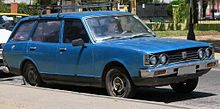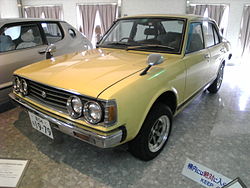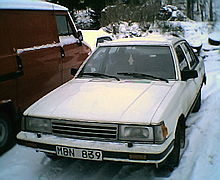- Daihatsu Charmant
-
Daihatsu Charmant Production 1974-1987 Predecessor Daihatsu Consorte Successor Daihatsu Applause Body style 4-door saloon
5-door station wagon (1st generation only)Layout FR Engine 1,290 cc 4K-U OHV I4
1,453 cc 3A-U SOHC I4
1,588 cc 2T OHV I4[1]Transmission 4/5-speed manual transmission
3-speed automatic transmission
3-speed automatic with ODWheelbase 2,400 mm (94 in) Length 165.5 in (4,204 mm) [1] Width 1,625 mm (64 in) Height 1,380 mm (54 in) Related Toyota Corolla (E30-E70) The Daihatsu Charmant is a compact sedan built by Daihatsu of Japan, based on the Toyota Corolla. It was replaced by the Daihatsu Applause. The Charmant was originally a spin-off of the Toyota Corolla of the 1970s; model changes paralleled that of the Corolla. All Charmants were fitted with Toyota inline-four engines, ranging from 1.3 to 1.6 litres. The word "charmant" is French for charming.
First generation

1980 Charmant WagonTrim levels were LC, LE and LGX; these continued until 1987 when the range was discontinued in the United Kingdom. The A35 body numbered Charmants were equipped with 1,300 cc engines. This type of engines were coded as 4K Toyota engines and came with a four- or five-speed manual transmission, as well as a three-speed automatic transmission. The 1,588 cc overhead valve 2T engine was also available, which could also be ordered with a three-speed automatic with overdrive.
Unique to the first generation, a station wagon was also available. This was called "Van" in the Japanese domestic market, where it is classed as a commercial vehicle.
Second generation
Renewed in October 1981, the new squarer bodywork was somewhat outmoded already when being introduced, as was its front-engine, rear-wheel drive layout. The only bodywork available is a four-door sedan. In Japan, the biggest engine was now an OHC 1.5 L (1,453 cc) with 83 PS (61 kW) at 5,600 rpm.[2] In the export, the 1.6 litre 2T engine was also available; power outputs ranged from 76 to 83 PS (56 to 61 kW) depending on compression ratios and intended markets. The smaller 1.3 litre engine produced between 62 and 74 PS (46 and 54 kW) depending on market and so on. All the engines were carburetted. In Japan, the most luxurious versions (with available climate control) were called "Altair".[3]
The Charmant had a independent front suspension (struts), and a live four-link rear axle. Suspension settings were soft, for maximum comfort.[3] The car underwent a minor facelift in autumn 1984.
The Daihatsu Charmant was aimed at the small executive saloon car market in Britain in 1980s, competing against hatchback-based saloons including the Ford Orion, Vauxhall Belmont and Rover 200. It also competed against continental offerings such as the Volkswagen Jetta. Production ended in late 1987, leaving a gap at the top of Daihatsu's lineup. In 1989, the Applause appeared to fill the Charmant's shoes.
References
- ^ a b Raikes, Myrrine (date June 1983). "Long-term test: Daihatsu Charmant 1.6LE". Drive (Magazine of the British Automobile Association) 95: pages 36–38.
- ^ Büschi, Hans-Ulrich, ed (March 5, 1987) (in German/French). Automobil Revue 1987. 82. Berne, Switzerland: Hallwag AG. pp. 242-243. ISBN 3-444-00458-3.
- ^ a b "Great Car Pavilion: '83 Daihatsu Charmant Altair G". Gazoo.com. Toyota Motor Corporation. http://gazoo.com/meishakan/meisha/shousai.asp?R_ID=3020. Retrieved 2011-10-06.
Current vehicles: Atrai/Hijet · Be-go/Terios · Boon/Sirion · Coo/Materia · Copen · Esse · Mira/Cuore/Charade · Mira Cocoa · Move · Tanto · Tanto Exe · XeniaPast vehicles: Altis · Applause · Bee · Ceria · Charade · Charmant · Compagno · Cuore · Consorte · Domino · Leeza/Leeza Spyder · Fellow Max · Max · Midget · Mira Gino/Trevis · Naked · Opti · Gran Move/Pyzar · Rocky/Feroza/Sportrak · Rugger/Rocky/Fourtrak · Sirion/Storia · Sonica · Taft/Scat · Taruna · Valera · YRVConcept Cars: ai · Basket · Copen (1999) · Costa · D-Bone · D-Compact X-Over · Deca Deca · Extol · EZ-U · FFC · HVS · Micros-3R · OFC-1 · SK-Tourer · SP-4 · U4B · UFE2 · UFE-III · X-021 · Mudmaster CRace Cars: P3 · P5Categories:- Modern auto stubs
- Daihatsu vehicles
- Vehicles introduced in 1974
- 1970s automobiles
- 1980s automobiles
- Rear wheel drive vehicles
- Sedans
Wikimedia Foundation. 2010.


